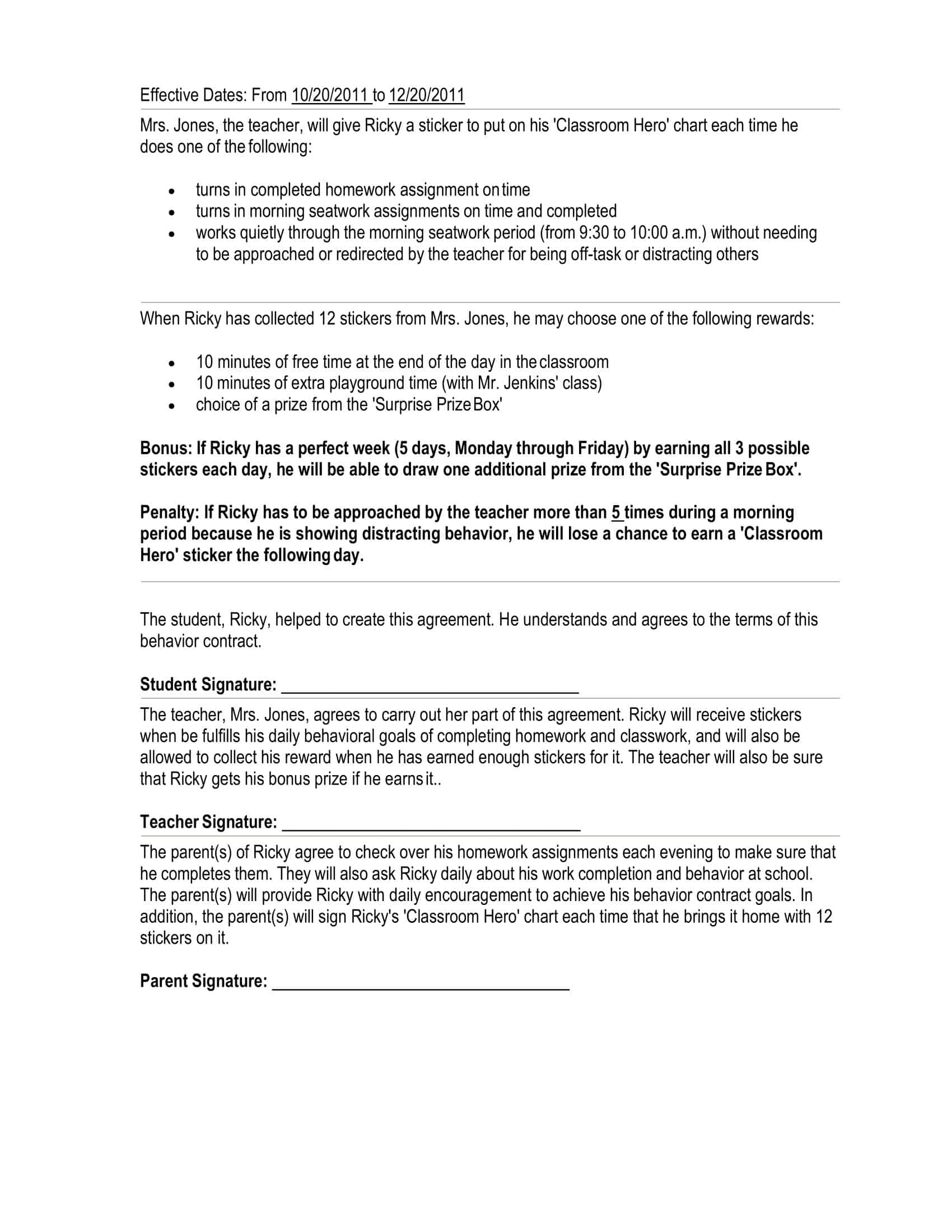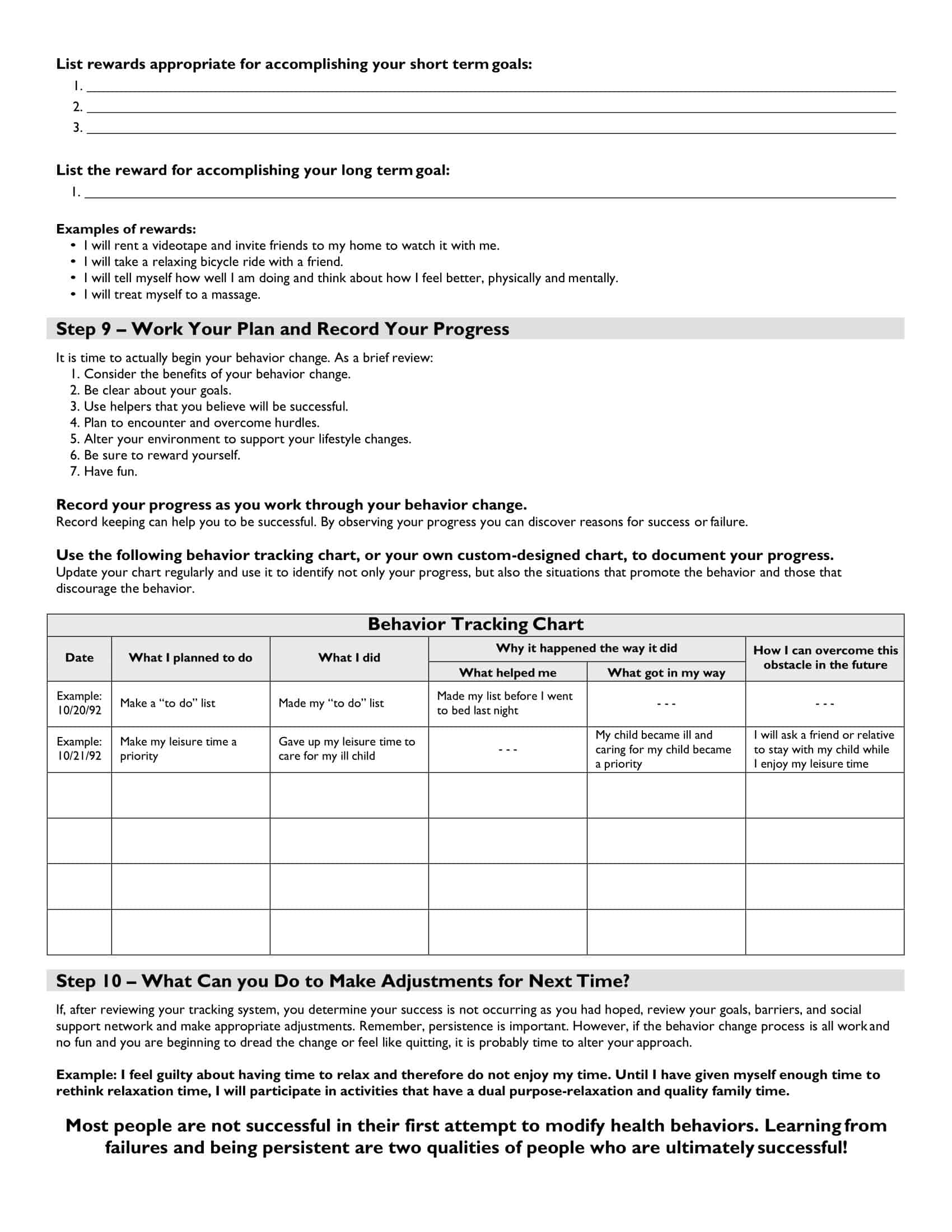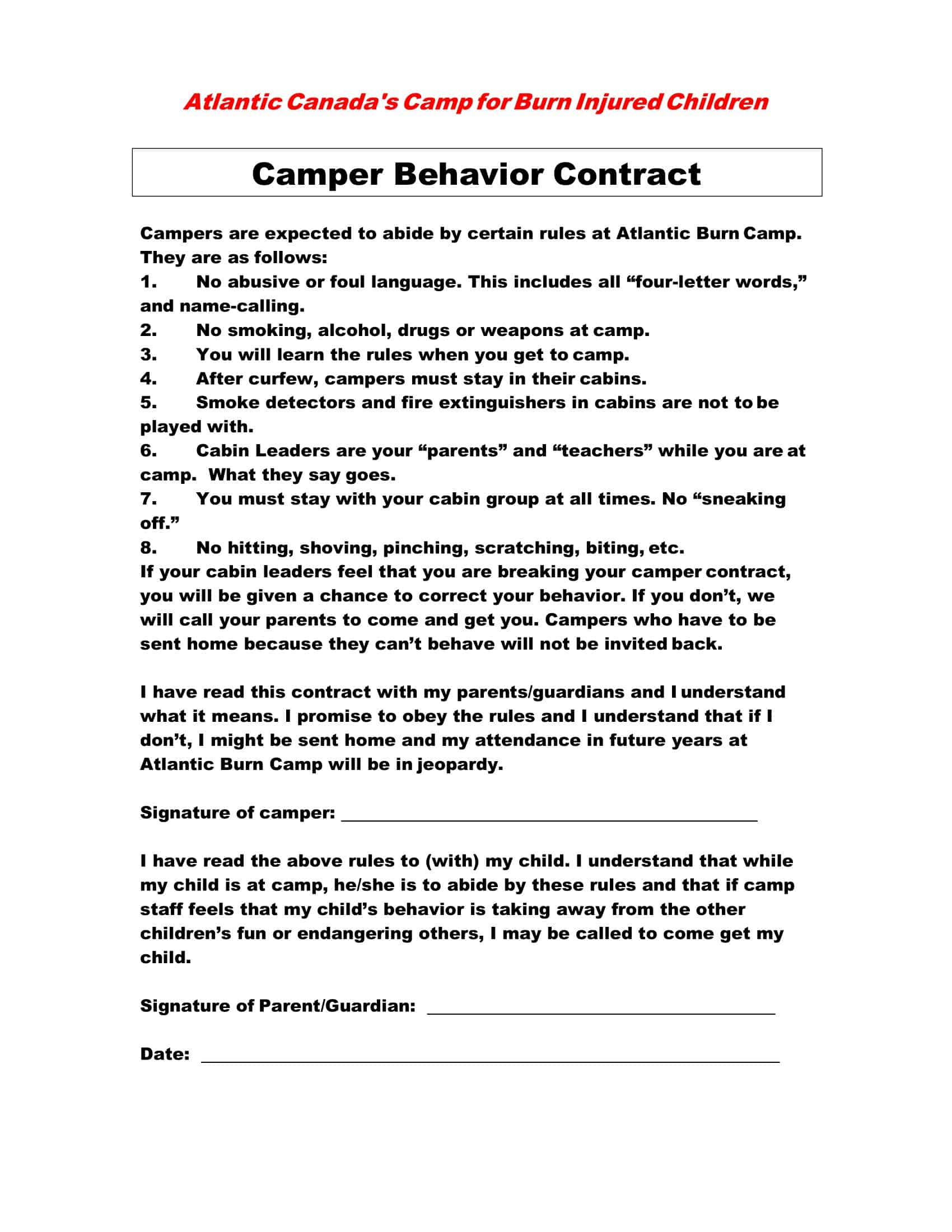A behavior contract is a tool used to clearly define expectations for desired behavior changes. It outlines the responsibilities of both the individual and the organization, such as a school, in working towards the desired behavior change.
These contracts can be beneficial for students of all grade levels and can help to make the process of behavior change more organized and efficient. Having a behavior contract template can also make it easier for educators to implement this strategy in their classrooms.
Table of Contents
Behavior Contract Templates
Behavior contract templates are pre-designed documents that establish clear expectations and guidelines for individuals in order to modify their behavior or achieve specific goals. These templates provide a structured framework for creating formal agreements between parties involved in behavior change programs, such as educators, therapists, parents, or individuals themselves.
Behavior contract templates typically include sections that outline the desired behavior, specific goals or targets, strategies or interventions to be implemented, rewards or consequences for meeting or not meeting the goals, and signatures of all parties involved. The contract sets forth the responsibilities and commitments of each party and provides a written record of the agreed-upon terms.
Using a behavior contract template helps establish accountability and structure in behavior change programs. It ensures that all parties involved have a shared understanding of the expectations and consequences, fostering a collaborative approach towards achieving positive change.
Benefits of using behavior choice contract

There are several benefits of using a behavior contract, including:
Clarity: A behavior contract clearly outlines the expectations for desired behavior changes, making it easy for both the individual and the organization to understand what is expected of them.
Accountability: By signing a behavior contract, both the individual and the organization are held accountable for their actions and are motivated to work towards the desired behavior change.
Collaboration: A behavior contract promotes collaboration between the individual and the organization as they work together to achieve the desired behavior change.
Self-reflection: By signing a behavior contract, individuals are encouraged to reflect on their behavior and take responsibility for their actions.
Flexibility: Behavior contracts can be tailored to meet the specific needs of the individual and the organization, making them a versatile tool for addressing a wide range of behavior issues.
Positive reinforcement: A behavior contract can be set up to include positive reinforcement for meeting the expectations, making the process of change more rewarding for the individual.
Empowerment: By being part of the process of creating and signing a behavior contract, individuals feel empowered and more invested in the behavior change process.
Type of Behavior Contracts
Behavior contracts come in various forms and can be tailored to meet the specific needs of the individual and the organization. There are several types of behavior contracts that can be used to address different behavior issues and concerns. Some common types of behavior contracts include positive reinforcement contracts, individualized behavior contracts, and group behavior contracts. Each type of contract has its own unique features and benefits, and can be used in different settings and for different purposes. Understanding the different types of behavior contracts and how to use them effectively can help educators and other professionals address behavior issues and promote positive change.
Here are some common type of behavior contracts:
Positive reinforcement contracts
These contracts focus on reinforcing desired behaviors by offering rewards or incentives for meeting certain behavior expectations. This type of contract is effective in increasing positive behaviors and can be used in various settings, such as classrooms, homes, and workplaces.
Individualized behavior contracts
These contracts are tailored to meet the specific needs and concerns of the individual. They focus on addressing specific problem behaviors and setting measurable goals for improvement. These contracts are commonly used in special education and counseling settings.
Group behavior contracts
These contracts are designed for a group of individuals, such as a class or a team. They outline expectations for group behavior and can be used to address issues such as bullying or poor sportsmanship. Group behavior contracts can be used in a variety of settings, including schools and sports teams.
Classroom behavior contract
This contract is used specifically in a classroom setting and outline the expectations of behavior for students. It also includes the consequences of not following the expectations and the positive reinforcement for following the expectations.
Parent-Child contract
This contract is used specifically between a parent and a child. It outline the expectations of behavior for the child and the consequences of not following the expectations. It also includes the positive reinforcement for following the expectations.
Therapeutic Contract
This type of contract is used in therapeutic settings, such as counseling, therapy, or rehab. It is used between therapist and patient to outline the expectations of behavior and the goals of the therapy.
Each type of behavior contract has its own unique features and benefits, and can be used in different settings and for different purposes. It is important to choose the right type of contract for the situation and to involve the individual in creating and signing the contract.
A middle school behavior change contract
A middle school behavior change contract is a tool used to clearly outline expectations for desired behavior changes for middle school students. The contract should be tailored to meet the specific needs and concerns of the individual student and the middle school setting.
The contract should include the following elements:
Specific behavior expectations
The contract should clearly outline the specific behavior that the student is expected to change. This could include things like staying on task in class, following school rules, or avoiding disruptive behavior.
Consequences for non-compliance
The contract should also outline the consequences for not meeting the behavior expectations. This could include things like a detention, loss of privileges, or a meeting with a counselor.
Positive reinforcement
The contract should include positive reinforcement for meeting the behavior expectations. This could include things like a reward, praise, or extra credit.
Goals
The contract should include measurable goals for the student to work towards. This could include things like improving their grades, increasing their participation in class, or reducing the number of disciplinary referrals.
Signatures
The contract should be signed by the student, the parent or guardian, and a school representative, such as a teacher or counselor.
Review and follow-up
The contract should include regular reviews and follow-up to track progress and make any necessary adjustments.
It’s also important to involve the student in creating and signing the contract, as it will make them more invested in the behavior change process and take responsibility for their actions.
A high school behavior change contract
A high school behavior change contract is a tool used to clearly outline expectations for desired behavior changes for high school students. The contract should be tailored to meet the specific needs and concerns of the individual student and the high school setting.
An adult behavior change contract
An adult behavior change contract is a tool used to clearly outline expectations for desired behavior changes for adults. The contract should be tailored to meet the specific needs and concerns of the individual adult.
How to Create Behavior Contract
Writing a behavioral contract is a process that involves several steps. Here is a step-by-step guide on how to write a behavioral contract:
Step 1: Identify the specific behavior that needs to change
The first step in writing a behavioral contract is to identify the specific behavior that needs to be changed. This could be a behavior that is causing problems in a particular setting, such as a classroom or workplace, or a behavior that is causing problems in an individual’s personal life. It’s important to be clear and specific about the behavior that needs to change.
Step 2: Define measurable goals
Once the specific behavior has been identified, the next step is to define measurable goals for the individual to work towards. These goals should be specific, measurable, and achievable. For example, if the goal is to improve classroom behavior, the goal might be to reduce the number of disciplinary referrals by 50% over the next three months.
Step 3: Outline the consequences for non-compliance
The contract should also outline the consequences for not meeting the behavior expectations. The consequences should be consistent with the severity of the behavior and should be agreed upon by all parties involved. The consequences should be clear and specific, and it’s also good to include graduated consequences, that means the consequences will get severe as the individual continues to break the contract.
Step 4: Include positive reinforcement
The contract should include positive reinforcement for meeting the behavior expectations. Positive reinforcement is a powerful tool that can be used to increase the likelihood of the desired behavior. Rewards can be tangible or intangible and should be chosen based on the individual’s preferences.
Step 5: Get signatures
The contract should be signed by the individual, the parent or guardian (if applicable) and the professional or organization responsible for the contract. This will ensure that all parties understand the expectations and consequences outlined in the contract.
Step 6: Review and follow-up
The contract should include regular reviews and follow-up to track progress and make any necessary adjustments. It’s important to monitor the individual’s progress and adjust the contract as needed to ensure that the desired behavior change is being achieved.
FAQs
What should be included in a behavior change contract?
A behavior change contract should include specific behavior expectations, consequences for non-compliance, positive reinforcement, measurable goals, signatures, and regular reviews and follow-up.
Who should sign a behavior change contract?
A behavior change contract should be signed by the individual, the parent or guardian (if applicable) and the professional or organization responsible for the contract.
How often should a behavior change contract be reviewed?
The contract should include regular reviews and follow-up to track progress and make any necessary adjustments. It’s important to monitor the individual’s progress and adjust the contract as needed to ensure that the desired behavior change is being achieved.
Can a behavior change contract be used for adults?
Yes, behavior change contracts can be used for adults as well. They can be tailored to meet the specific needs and concerns of the individual adult and can be used in various settings such as therapy, rehabilitation, or workplace.
Can a behavior change contract be used for children?
Yes, behavior change contracts can be used for children as well. They can be tailored to meet the specific needs and concerns of the child and can be used in various settings such as schools, homes and therapy.
Can a behavior change contract be used for an organization?
Yes, behavior change contracts can be used for organizations as well. They can be used to set expectations for employee behavior, improve workplace culture, and establish a code of conduct.
How can I make sure a behavior change contract is effective?
To ensure that a behavior change contract is effective, it’s important to involve the individual in creating and signing the contract, to make it clear, simple and easy to follow, to set specific, measurable, and achievable goals, and to include regular reviews and follow-up to track progress and make any necessary adjustments.
Is a behavior change contract legally binding?
A behavior change contract is not legally binding, but it is a tool that can be used to establish clear expectations and consequences for behavior. It can be helpful to have an attorney review any legal concerns related to a behavior change contract.
Are there any potential drawbacks to using a behavior change contract?
Some potential drawbacks to using a behavior change contract could be that the individual may not fully understand the contract or may not take it seriously, or that the contract may not address underlying issues that are causing the problem behavior. It’s also important to make sure that the contract is not being used in a way that is punitive or harmful to the individual.




















































![%100 Free Hoodie Templates [Printable] +PDF 1 Hoodie Template](https://www.typecalendar.com/wp-content/uploads/2023/05/Hoodie-Template-1-150x150.jpg)
![Free Printable Catering Contract Templates [Word, PDF] Simple 2 Catering Contract](https://www.typecalendar.com/wp-content/uploads/2023/05/Catering-Contract-1-150x150.jpg)
![Free Printable Land Contract Templates [Word, PDF] Simple 3 Land Contract](https://www.typecalendar.com/wp-content/uploads/2023/05/Land-Contract-1-150x150.jpg)
